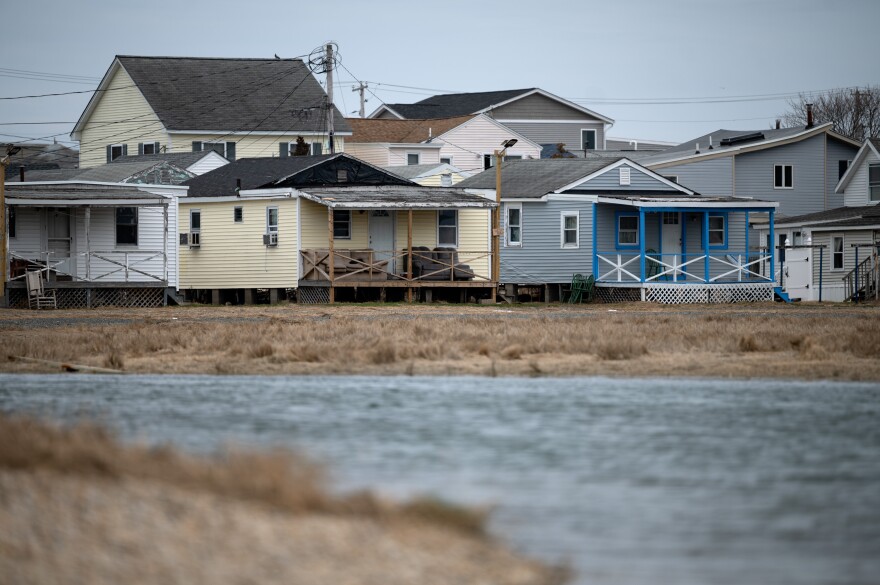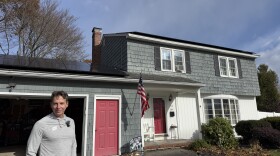People living on and off the coast of New England will soon be at a greater risk from flooding due to heavier rain and rising seas caused by climate change.
Global warming will put more pressure on the federal flood insurance program, which is already overstretched, prompting an overhaul to be completed later this year.
Regulators hope the change will make the system more fair, sustainable and climate-conscious. But some homeowners worry it’ll drive up their rates.
This story is part of special coverage for Earth Week from NHPR's By Degrees project, the New England News Collaborative and Covering Climate Now, a global journalism collaboration strengthening coverage of the climate story. Click here to see more from around the region.
Who has to have federal flood insurance in New England?
You’re required to have flood insurance if you have a federally-backed mortgage and you live in a flood hazard zone, as mapped by the Federal Emergency Management Agency. These flood zones are found on and off the coast, in tidal areas, river floodplains and more.

FEMA says about 7,700 people currently have flood insurance in New Hampshire. The usage is similar in Maine, with a few thousand policies in Vermont and tens of thousands in Southern New England.
Policies can cost anywhere from hundreds to thousands of dollars a year, and provide reimbursement when a home is damaged in a flood. In the past decade, the average flood insurance payout in New Hampshire was about $17,000, according to FEMA.
The agency periodically redraws its flood maps to account for changing risk levels. They added many homes to the program in New Hampshire after the Mother’s Day and Patriot’s Day floods of 2006 and 2007 -- costly disasters caused by days of steady rain, the kind that's expected to happen more often as the climate warms. About a quarter of the roughly 4,000 flood insurance claims filed in the state since 2005 came soon after those floods, according to state regulators.
How will climate change increase the risk of costly flooding?
About 4 million homes and small apartments in the U.S. are currently at risk of damage from substantial flooding, according to a recent NPR analysis of data from the nonprofit First Street Foundation, which models flood risk based on climate change projections.
This data suggests that about 3,700 more properties in New Hampshire will be at risk by 2050, an increase of close to 5%. The foundation predicts that the cost of that potential flood damage will increase about 10%. The increases are more dramatic in flood-prone coastal areas like Portsmouth and Hampton Beach, each of which will have about 30% more properties at risk of flooding by mid-century.
For a better experience on mobile, you can view the map here. You can look up the risk for any address in the country using First Street’s database.
What do homeowners think about their flood insurance and their level of risk?
Elizabeth Dubrulle, Goffstown: "We're not daredevils. We usually like to be well-insured for what we think of as credible threats. But this amount of money for something that is so unlikely is something we would never pay for of our own choice."

Dubrulle lives by an unnamed creek off the Piscataquog River. She's in a FEMA-designated flood zone and is required to have increasingly expensive flood insurance. Her current premium is about $3,600 a year, up from $1,500 when she was first required to get it. But she doesn't think she's at risk, and she's working to pay off her mortgage early so she can drop the policy.
Deb Bourbeau, Hampton Beach: “We always said, ‘Oh wow, look, now we truly have oceanfront property,’ because it's just swirling around your house. It really is cool to see, and then sometimes it gets a little scary.”

Bourbeau's weekend home looks out over the tidal marsh in Hampton’s west end. She carries flood insurance voluntarily, and her home’s elevated foundation has helped lower her premiums. Nuisance flooding during high tides is an increasingly routine occurrence in her neighborhood.

Jon Cook, Bradford: "I will never use this insurance because of the way my camp is built."
Cook's summer camp sits on an inlet between Lake Massasecum and the Warner River. The property has flooded in the past, but he renovated the house to avoid damage and hasn’t had a problem since. He is required to have flood insurance, and his costs are increasing.
Judy Miskelly, Hillsborough: "I saw how close the water has come. I know the climate is changing. … I do believe that there's a chance that my home could flood, but I also understand that the cost to replace it isn't going to be a million dollars."

Miskelly's home in Hillsborough sits feet from Sand Creek and was hit hard, before she bought it, during the Mother's Day floods of 2006. It's been upgraded to be more flood-resistant. She's glad to have insurance coverage, but is worried about unfair, unexpected increases in cost.

Is the flood insurance system fair? What is FEMA doing to modernize it?
NPR's analysis of the First Street data earlier this year found that lower-income communities and people of color tend to pay higher premiums for a lower level of risk, while wealthier, whiter communities pay lower premiums for a higher level of risk.
NPR also found that New Hampshire had one of the biggest gaps between the "good deal" or "bad deal" people are getting depending on their income level. This disparity could be partly driven by the number of second homes and oceanfront properties in the program -- about half of New Hampshire's flood insurance policies are on the Seacoast.

FEMA's current risk rating system doesn't account well for home values, or climate change. Homes built before the system began in the late 1960s are also able to access lower rates. Critics of the system argue that wealthy policy-holders are more able to rebuild and handle expensive losses, and that lower-income homeowners pay for that disproportionately.
To address those problems, and to make the under-funded program more sustainable and responsive to climate change, FEMA is releasing what it calls "Risk Rating 2.0" this coming October. Its goal is to spread costs out more equitably, with more weight given to factors like home values. In theory, it could mean homeowners like Judy Miskelly in Hillsborough won't pay more than it would actually cost to fix their home if it flooded.
But FEMA hasn't released much information about whose rates will go up and whose will go down under the new system. Click here to see FEMA's latest estimates of how rates will change in general in each New England state.

Data in this story came from NPR and the First Street Foundation. Graphics by NHPR's Casey McDermott. Do you have a story to share about flooding or flood insurance? Drop us a line at climate@nhpr.org, or take a quick survey to help shape future climate change coverage.








